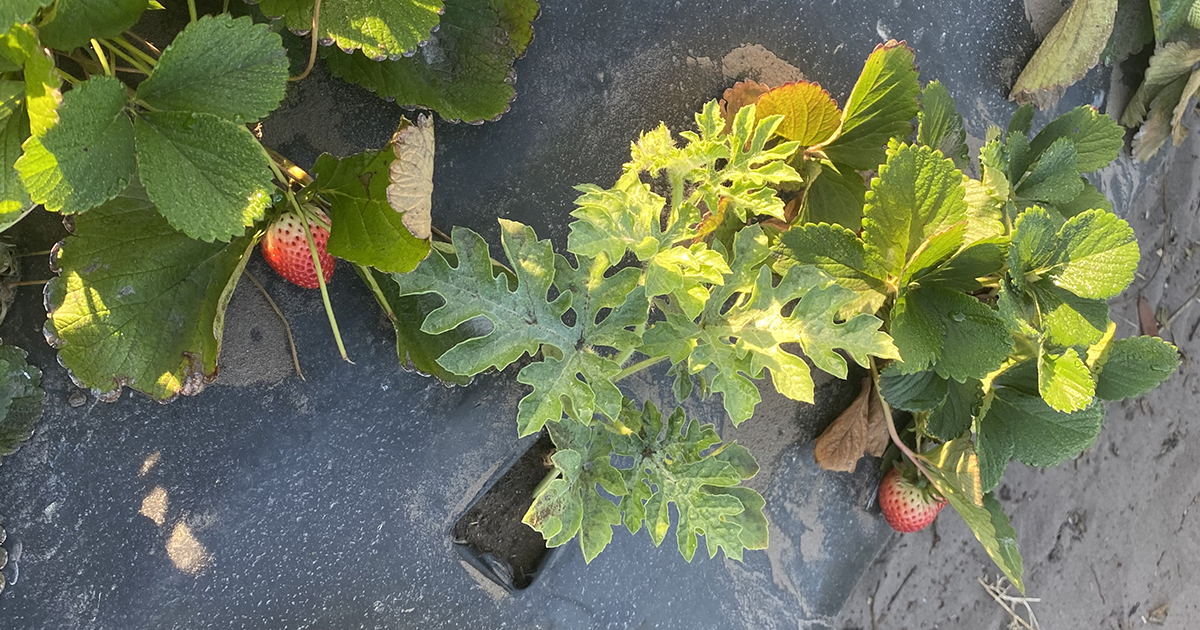With Larry Cooper

Jason Garcia
A few weeks ago in this space I wrote about vegetable growing with Huma Gro®. Today I’m writing about melons—which are a whole different proposition. In my part of Florida, growers frequently follow their strawberry crop with melons (typically watermelons or cantaloupes), seed-planted right into the strawberry beds while the strawberries are still producing their final fruits of the season. The plastic mulch and drip tape are still in place, but the fertilizer applications have wound down so as not to soften the berries and invite disease.
Bed Preparation
When the melon seeds are planted, we hope that it is into strawberry beds that have been using our Promax®/Zap® fumigation-replacement program. If so, then that program can continue through the drip irrigation right through seed planting and all the subsequent melon growth stages till harvest without interruption. If the beds weren’t on a Promax®/Zap® program for the strawberries, we recommend that you implement it for your melons; fumigation isn’t an option for the way this second crop is grown, but nematodes and soil-borne diseases can still severely damage your crop if they are allowed to take hold. Here’s a quick reminder of our Promax®/Zap® program that is much safer than fumigation, has no restrictions, and can be less than half the cost.
Huma Gro® Promax® is an organic, OMRI-Listed fungicide/nematicide that can be applied through irrigation with no mandatory safety restrictions involved. You can put out a half-gallon per acre through the drip (or 1 gallon per acre broadcast) 2 weeks prior to planting to get the soil protection going by knocking down the pathogenic microorganisms in the soil, and follow up 2 weeks later with a half-gallon of Zap® to rebuild a healthier, more diverse soil microbial community that will actually benefit the crop.
We repeat this irrigation application cycle throughout the growing season—alternating Promax® and Zap® every 2 weeks—to keep soil-borne diseases and nematodes under control. We’ve all seen how fumigation can wear off in the middle of a growing season, and yields can take a hit at that point. There’s nothing a grower can do about it with more fumigation, because you can’t fumigate a live crop. But a continuous cycle of Promax® and Zap® through the irrigation will control nematodes and soil disease throughout the growing season to give you the best yields possible.
One of the best benefits for our region is that the application of Promax®/Zap® is not influenced by the weather. Last year we had a lot of rain just before strawberry-planting time and growers who were still dependent on fumigation were delayed with planting because they couldn’t fumigate in the wet soil (see 9-5-2019 blog). Growers using Promax®/Zap® were able to stay on schedule because they could put out Promax®/Zap® with irrigation, even in the wet fields, and the products did their job to ensure a safe planting.
Now, if you are really tied to the idea of fumigation, you can still use Promax®/Zap® throughout the season after fumigation to prevent that mid-to-end-season dip when the fumigation wears off. But many of our growers have found that Promax®/Zap® can completely replace fumigation, saving them money and still producing great crops.
Planting and First Growth
As mentioned above, the melon seeds are typically planted into the strawberry beds while the strawberries are producing their final fruits of the season. We typically don’t apply any additional fertilizer at melon seeding so as not to disrupt the berries, but this effectively means that the melon seedlings are starving their first few weeks until the berries are cut out and the melons become the dominant crop. At the strawberry-removal stage, the melons typically have vines that are a foot or so in length, and it is time to start fertilizing them.
At this point, typical melon growers are going to start applying a 9-2-7 NPK fertilizer through the drip that they continue to run through the season. That’s a conservative approach that is not going to get the best yields or the best quality. Our recommendation for jumpstarting the melons and getting them off to a great start is to add a pint/ac each of Super Phos®, Vitol®, and Breakout® to that drip-applied NPK.
- Super Phos® is going to bring that young plant out of starvation mode and give it the energy needed for rapid growth.
- Vitol®® feeds the natural metabolic processes within the plant for vegetative development and fruit sizing. It increases the nutrient uptake of the plant and smoothly transitions the plant through its growth stages. It also improves plant recovery from environmental stresses during peak crop demand periods (see video).
- Breakout®, though, is the key product in watermelon production. Breakout® is designed to feed the natural metabolic process within the plant for enhanced bud initiation, flowering, and fruit set. Growers consistently tell us that when their watermelon fields bloom after applying Breakout®, they have the most beautiful, bloom-laden fields they have ever seen (see video). This requires a critical change in basic fertilizer application, though. More blooms mean more watermelons, and more watermelons require more nutrition than the traditional grower’s standard fertilizer program will be able to provide. The additional blooms tell you what the watermelon plant is capable of producing, but to achieve that higher yield of viable, high-quality melons you’re going to have to step up your basic nutrition program. This may include bumping up the 9-2-7, but it may also involve some additional Huma Gro® products.
- Let me be clear, though, that when it comes to Breakout®, this is one instance in which cantaloupes are much different than watermelons. Cantaloupes naturally produce a lot more blooms than watermelons: applying Breakout® on cantaloupes would produce so many blooms that a grower would never be able to apply enough fertilizer to support them all. We do not recommend Breakout® on cantaloupes: substitute Golden Pro®, instead.
As the vines mature and begin to provide enough “green” to make foliar sprays viable, it’s time to start doing some tissue testing to determine what nutrients the plants are needing. Of course, you are going to want to continue adding Breakout® (or Golden Pro® for cantaloupes) and Vitol® to the foliar mix every week or two. You may also find that Huma Gro® Calcium (or Pur Cal®, if a nitrate-free version is called for) and Super Phos® are needed. Micronutrient deficiency associated with all that growth will call for some Max Pak®, and with melons you never want to get behind on potassium or you may never catch up. Our Super Potassium® product is a great solution for this need.
At Fruiting and Beyond
Just after blooming or when the fruits start to develop, it is time to replace the routine Super Phos® with foliar applications of Golden Pro® at a pint/acre to increase brix levels .Once the fruit has set, then continue with weekly foliar applications of Vitol® and Breakout®—adding in Max Pak®, Calcium, and Super Phos® as need is determined by tissue testing. As mentioned earlier, you’ll also be continuing the Promax®/Zap® regimen through this period till harvest is completed.
Dealing With the Non-Routine
As I stated earlier, Huma Gro® offers over 50 products, and quite a few of them are for special needs and won’t be routinely applied in normal situations. But when you need them, you’ll be very glad we’ve got them. Here are some examples:
- Beat-Up Vines—Wind and rain can do a number on your melon vines, leaving them looking ragged. This is a good time for Sili-Max®, a silica product that increases the strength and rigidity of the plant, increases water retention, and improves plant turgor pressure. It also increases plant resistance to environmental stresses.
- Insect Pressure—Killing the bugs is not your only tool when dealing with insect pressure. You also want to give your plants the proper nutrition to cope with that insect pressure. D-Fend® was designed just for that purpose, to nutritionally help plants deal with insect pressure. It kicks the plant into a mode that helps the plant better “defend” itself against insects, making the plant less desirable to them. If it does get to the point where it is necessary to start killing bugs, consider our OMRI-Listed Proud 3® product, a broad-spectrum insecticide, miticide, and fungicide.
- Fungal Pressure—Similarly, you can provide plants with the extra special nutrition they need when they are under fungal pressure by applying Activol®.
- Miscellaneous Factors—Sometimes the plants just look “anemic,” something unspecified is going on that seems to be sapping the vigor out of the plants and making them susceptible to disease. Crop-Gard® (formulated from Activol®, Vitol®, and Z-Max®—which contains zinc, copper, and manganese) can make the leaves thicker and greener, making it very difficult for disease to get in. When mixed with your Vitol® application, there is a synergistic effect that can really bring those plants back around.
Partner With Your Huma Gro® Representative to Create Your Best Crop Nutrition Program
We have over 50 products in our Huma Gro® line of crop nutrition and crop protection products (and 25 more in our Fertilgold® Organics line). Why so many? Each of those products was created to solve a particular problem, and you know that farmers have a lot of problems to solve when producing high-quality, high-yielding crops. The challenge is in fully understanding each of these products and using them appropriately to solve your particular problem. As your Huma Gro® representative, that’s where I come in.
The part of my job in which I take the most pride and satisfaction is in helping my customers solve problems. Oftentimes I can do that by recommending the correct Huma Gro® product to apply in the correct amount at the correct time. But sometimes I can also help with a solution that has nothing to do with selling you a product. Sometimes I can provide a solution because I’ve lived and worked in my sales area all my life and have been involved in the technical aspects of farming for over 25 years. That’s a value-added service that I’m very happy to provide to my customers (I’ve even been known to pull customers’ trucks out of mudholes a time or two).
You’ll notice that in this blog post I did not provide much in the way of set, prescribed nutrition programs. I could have provided some generic programs, but with Huma Gro® we know that the best yields are going to happen when we customize a program based on your crop, at a specific growth stage, on your land, with your soil history, and with your crop goals for this year in this year’s market. We can’t provide that level of customization unless we’re talking to you and seeing your crop in your field. Even more so, we want to train our growers in how to use our products to “paint the picture” of the crops they want to grow. Does the crop need a little more green? Use this product. Does it need a little more vigor? Use that product. Will the best price be obtained if the crop is ready for market on a specific date? Use these products to bring the crop in on schedule. Selling Huma Gro® is not simply a financial transaction; it’s also a knowledge and experience transaction. When you become our customer, you’ve gained a partner who wants to help you succeed and who has the tools to do so.
Jason Garcia was born and raised in Plant City, Fla., where he grew up on a farm before he became involved in the technical aspects of farming. As BHN’s Florida Sales Agronomist, Jason has 25+ years’ experience helping growers improve their crops. Contact Jason at jason@humagro.com.
Huma Gro® products with Micro Carbon Technology® rapidly deliver essential nutrition to crops for optimal growth, fruiting, and vigor. The results are higher quality harvests, increased crop yields, and maximum profit.
Huma Gro® Products Mentioned:
- Activol®—product technical bulletin.
- Breakout®—product technical bulletin.
- Calcium—product technical bulletin.
- Pur Cal®—product technical bulletin.
- Crop-Gard®—product technical bulletin.
- D-Fend®—product technical bulletin.
- Golden Pro®—product technical bulletin.
- Max Pak®—product technical bulletin.
- Promax®—product technical bulletin.
- Proud 3®—product technical bulletin.
- Sili-Max®—product technical bulletin.
- Super Phos®—product technical bulletin.
- Super Potassium®—product technical bulletin.
- Vitol®—product technical bulletin.
- Z-Max®—product technical bulletin.
- Zap®—product technical bulletin.
Related Posts

Flooded Fields, Missed Chances: The Cost of Untimely Rain
Too much rain at the wrong time can ruin a season. In May, Delta farmers were hit with nearly double the average rainfall, flooding fields and delaying crucial work. From missed nitrogen applications to replanting setbacks, timing is everything—and this spring, Mother Nature threw a major curveball.

This Week in Ag #29
We all do it. We track time by referencing memorable items that we or our family once possessed. “Back when he drove that blue Silverado”, or “when she had that yellow Labrador” are examples of how we recall events that shaped our lives. For farmers, those points in time are often defined by a tractor.

Cooperation That Grows Communities
October is National Cooperative Month, a time to recognize the organizations that keep rural communities thriving. From providing essential services to marketing crops and supplying inputs, cooperatives embody the power of working together. Their member-owned model ensures that success is shared, making cooperation truly the foundation that grows communities.


